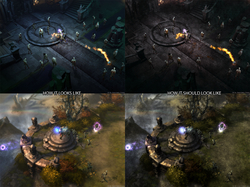 As Bob Dylan once wrote, “The times they are a-changin'” and id Software may be ready to change with these times. They’re talking at Quake Con about both DOOM 4 and their next title Rage (a first person shooter car driving game) both utilizing the same engine, the Tech 5 engine, and being developed simultaneously.
As Bob Dylan once wrote, “The times they are a-changin'” and id Software may be ready to change with these times. They’re talking at Quake Con about both DOOM 4 and their next title Rage (a first person shooter car driving game) both utilizing the same engine, the Tech 5 engine, and being developed simultaneously.
Now, this doesn’t mean you’ll have dual release games but it shows that id Software is ready to work on more than a single project at the same time, a big step for them. Although they’re usually working a big engine while finishing up a title to run on such an engine, they’ve got two titles in the works. This is very unlike the little FPS company but it shows they’re ready to meet the challenge of a larger industry.
When the original DOOM arrived there was nothing to compete against them and through the years and into Quake their competition was light years behind. Developers like Epic Games, Bungie and other first-person-shooter genre developers have proven themselves in the industry with many titles and sequels while id releases, seemingly, one game every five years.
For a company with only one or two franchise titles they do take a long time to release another game. This may be due to their engine licensing, no longer under the “Quake” engine name and sticking with its own independant naming convention like ID Tech 4 and ID Tech 5, they’re showing us the company is about engine design seperate from any demos or game prototypes they provide to show off the engine.
To many gamers DOOM 3 was more of a prototype to show people how far graphics have advanced in the last twenty years. Many folks were excited to play but grew bored when they realized it was very much like DOOM 2 but with a graphic revamp. Nostalgia only goes so far before you realize the story and depth behind games like Half-Life, Unreal and Halo have far exceeded a extreme graphical FPS gaming.
It’s time for id to grow from their roots and expand into many game genre’s and build out new independent properties (like Rage) to show the industry they’re not just a one-hit wonder with a huge fan base.
But, you can’t argue with a huge fan base. They’ve got a full conference to show off their stuff, not even Electronic Arts has that!
(Thanks, 1up)

 The game industry, like other entertainment avenues, is a risky business in which publishers have to pick titles they “predict” will do well in the market while passing on other “risky” propositions. While a the good ol’ shooter title will break sales records, the market cannot rely on one genre to carry the business especially considering many of these titles are forgotten within two months from launch. Publishers are going to be forced in expanding their reach to “family games” in order to finance new blockbuster titles.
The game industry, like other entertainment avenues, is a risky business in which publishers have to pick titles they “predict” will do well in the market while passing on other “risky” propositions. While a the good ol’ shooter title will break sales records, the market cannot rely on one genre to carry the business especially considering many of these titles are forgotten within two months from launch. Publishers are going to be forced in expanding their reach to “family games” in order to finance new blockbuster titles. The idea of designing a “family” game isn’t new to our industry, as a matter of fact, it’s one of the oldest cornerstones of video game entertainment. Pong, Centipede, Pac-Man, Space Invaders and many other classic titles were no doubt playable by the entire family, but things have changed. We’ve evolved from hit titles like Donkey Kong to hit titles like Halo. We migrated from 2D gaming to full 3D adventures and pixel graphics to pixel shaders, but where do we go next?
The idea of designing a “family” game isn’t new to our industry, as a matter of fact, it’s one of the oldest cornerstones of video game entertainment. Pong, Centipede, Pac-Man, Space Invaders and many other classic titles were no doubt playable by the entire family, but things have changed. We’ve evolved from hit titles like Donkey Kong to hit titles like Halo. We migrated from 2D gaming to full 3D adventures and pixel graphics to pixel shaders, but where do we go next? There has been many debates on the graphic level of Diablo 3 and how it should be different. Finally a developer comes out and says “um, no.” Their reasoning is fairly simple, it’s one thing to photoshop up a screenshot with some filters but it’s another to get the texture and lighting to run at that detail on a standard computer.
There has been many debates on the graphic level of Diablo 3 and how it should be different. Finally a developer comes out and says “um, no.” Their reasoning is fairly simple, it’s one thing to photoshop up a screenshot with some filters but it’s another to get the texture and lighting to run at that detail on a standard computer.
0 thoughts on “ID Software, Not Just One Game Anymore”